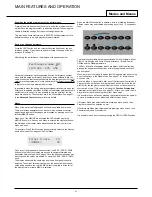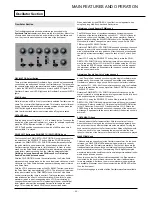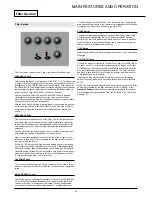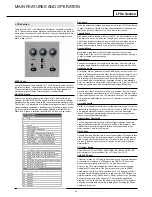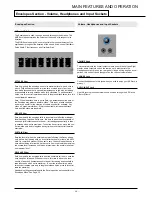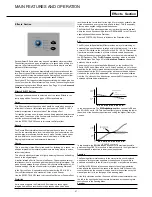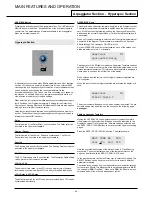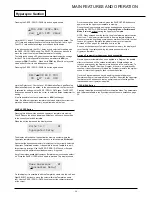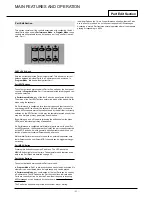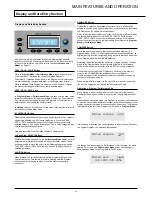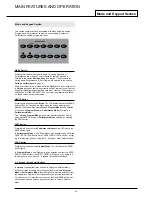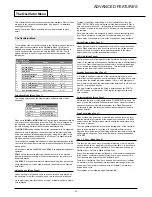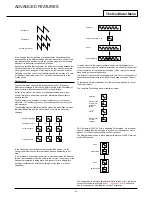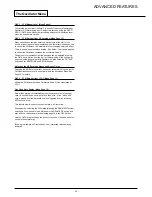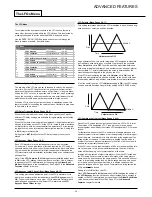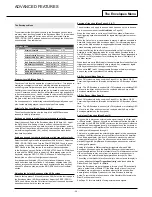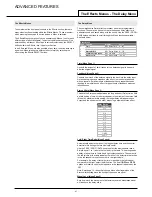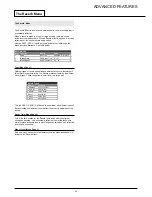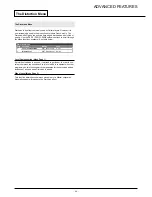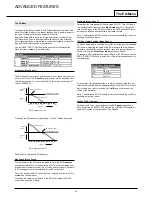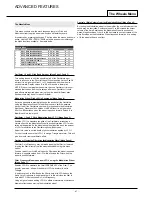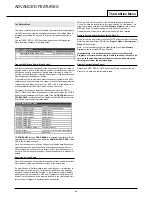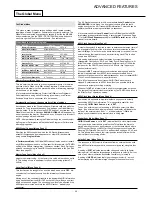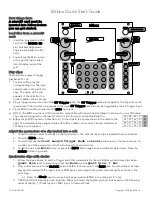
ADVANCED FEATURES
The Oscillator Menu
•
35
•
It can be seen that the resulting synced waveform has subsequently
been modified into a different shape. Altering a waveform’s shape in this
way introduces new harmonics into the sound which gives the resulting
waveform its distinctive synced sound qualities.
It should be realised that the greater the difference in tuning between the
Oscillator waveforms, the more pronounced the sync effect will become,
since more drastic changes will be made to the final synced waveform.
Changing the pitch of one of the Oscillators during the duration of a note
(for example, modulated by an LFO) will add a dynamic quality to the
synced sound.
FM Synthesis
The next two menu options allow sounds based on FM (Frequency
Modulation) synthesis to be created. Before looking at the operations of
these controls, a little explanation of FM synthesis follows.
Earlier in this manual, the basics of subtractive synthesis were intro-
duced. Terms such as harmonics, timbre, waveforms and oscillators
became familiar.
FM Synthesis is the technique of using
one waveform to Frequency
Modulate - FM- another to produce a resultant more harmonically com-
plex waveform.
The following diagram illustrates that the higher the modulation between
the Modulating wave and the Carrier wave, the more the waveform
changes.
In the illustration, the Oscillators are producing Sine waves. It is the
change
in harmonics over time that makes a sound interesting to our
ears.
In FM synthesis, an envelope generator is inserted between the modula-
tor and carrier waveforms so that there is control over of how much of the
frequency modulation is taking place with respect to time. Adding this
envelope constructs the basic FM building block as shown in the nex
illustration.
It can be seen that the output waveform begins, being identical to the
carrier, but becomes more complex (harmonics are added) as the amount
of FM modulation increases via the envelope. It then returns to a simple
wave again as the envelope decays.
The timbre of the Waveform is changing with time
. This is the opposite of
subtractive synthesis where a
low pass Filter
is used to
remove harmon-
ics.
To complete a simple synthesizer, a further envelope is added to control
the output volume.
The complete FM building block is illustrated below.
OSC 2 is able to FM OSC 3 via a dedicated FM envelope.
It is important
that it is realized that this Envelope is used only for FM purposes and is
not
one of the Envelopes available on the front panel
.
The diagram below shows in block diagram format how the KS Rack can
produce FM sounds.
The easiest way to be totally familiar with FM is to take one of the factory
preset FM sounds, for example
Bank 2 - 09 (Sound 209)
, a bell sound
and to experiment by modifying the various FM settings.
osc 1- modulator
osc 3- carrier
output waveform
modulation level = 0
= 30
= 90
Modulator Oscillator
Modulation Level = 0
Carrier Oscillator
Output Waveform
= 30
= 90
osc 1- modulator
osc 3- carrier
output waveform
envelope
modulation
level = 20
Modulator
Envelope Modulation = 20
Carrier
Output Waveform
modulator
env - used to
control FM
modulation
amount
env - used to
control amplitude
of sound over
time
carrier
Modulator
Carrier
Envelope used
to control FM
Modulation
amount
Envelope used
to control
Amplitude
Osc 3
Operator 1
Operator 2
Osc 2
FM Env
Amp Env
OSC 2
OSC 3
FM Envelope
AMP Envelope
Oscillator 1
Oscillator 2
Synced waveform

